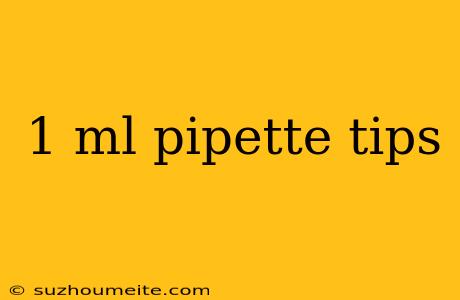1 mL Pipette Tips: Precise Liquid Handling for Laboratory Applications
Introduction
Pipette tips play a crucial role in laboratory settings, enabling scientists to accurately and precisely transfer small volumes of liquids. Among the various types of pipette tips available, 1 mL pipette tips are a popular choice for many laboratory applications. In this article, we will delve into the features, advantages, and applications of 1 mL pipette tips.
Features of 1 mL Pipette Tips
1 mL pipette tips are designed to work with pipettes that have a maximum volume of 1 milliliter. These tips are typically made from high-quality plastics, such as polypropylene or polyethylene, which provide excellent chemical resistance and durability. Some common features of 1 mL pipette tips include:
- Sterile and pyrogen-free: Many 1 mL pipette tips are sterilized using gamma radiation or ethylene oxide, making them suitable for use in sensitive biological applications.
- ** Graduations**: Some 1 mL pipette tips feature graduated markings, allowing users to accurately measure the volume of liquid being transferred.
- Filter tips: Some pipette tips come with built-in filters, which help to prevent aerosol contamination and minimize the risk of sample loss.
Advantages of 1 mL Pipette Tips
1 mL pipette tips offer several advantages over other types of pipette tips, including:
- Accuracy: 1 mL pipette tips are designed for precise liquid handling, reducing the risk of errors and inconsistencies in laboratory results.
- Convenience: These tips are often designed for single-use, eliminating the need for tip washing and sterilization.
- Cost-effective: 1 mL pipette tips are often more affordable than larger pipette tips, making them a cost-effective choice for many laboratory applications.
Applications of 1 mL Pipette Tips
1 mL pipette tips are commonly used in a variety of laboratory applications, including:
- Molecular biology: 1 mL pipette tips are often used in molecular biology techniques, such as PCR, DNA sequencing, and gene expression analysis.
- Cell culture: These tips are used to transfer small volumes of cell culture media, reducing the risk of contamination and ensuring accurate results.
- Chemical analysis: 1 mL pipette tips are used in chemical analysis techniques, such as HPLC and GC, to accurately transfer small volumes of samples and reagents.
Conclusion
In conclusion, 1 mL pipette tips are an essential tool in many laboratory applications, offering precision, convenience, and cost-effectiveness. By understanding the features, advantages, and applications of these tips, scientists can ensure accurate and reliable results in their laboratory work.
